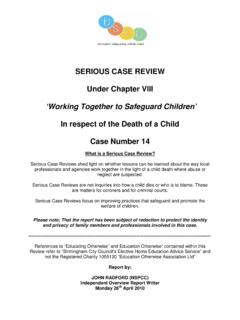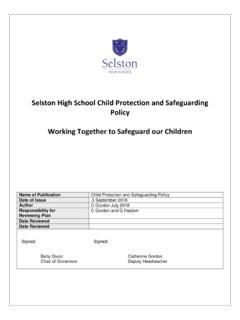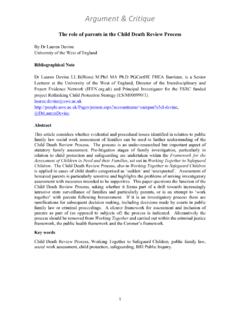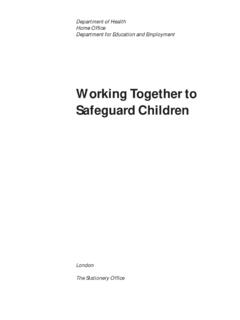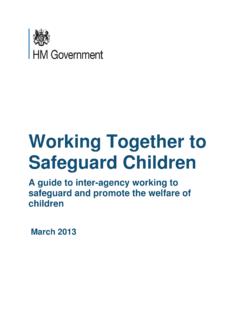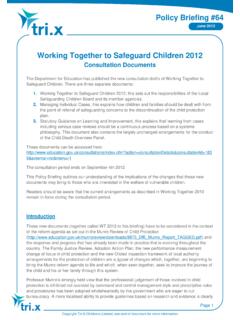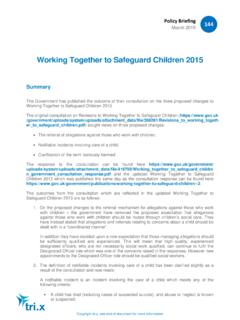Transcription of Working Together to Safeguard Children - UCL Institute of ...
1 Working Together to Safeguard Children Consultation Document A guide to inter-agency Working to Safeguard and promote the welfare of Children December 2009. A guide to inter-agency Working to Safeguard and promote the welfare of Children 1. Chapter 1 Introduction: Working Together to Safeguard and promote the welfare of Children and families Supporting Children and families All Children deserve the opportunity to achieve their full potential. In 2003, the Government published the Every Child Matters Green Paper alongside the formal response to the report into the death of Victoria Climbi . The Green Paper set out five outcomes that are key to Children and young people's wellbeing: be healthy;. stay safe;. enjoy and achieve;. make a positive contribution; and achieve economic wellbeing. The Children Act 2004 subsequently became law and set out these outcomes in statute, as well as the Government's approach to the well-being of Children and young people from birth to age 19.
2 To achieve these outcomes, Children need to feel loved and valued, and be supported by a network of reliable and affectionate relationships. If they are denied the opportunity and support they need to achieve these outcomes, Children are at increased risk not only of an impoverished childhood, but also of disadvantage and social exclusion in adulthood. Abuse and neglect pose particular problems. Parenting, family life and services Patterns of family life vary and there is no one, perfect way to bring up Children . Good parenting involves caring for Children 's basic needs, keeping them safe and protected, showing them warmth and love, and providing the stimulation needed for their development and to help them achieve their potential, within a stable environment where they experience consistent guidance and boundaries. 2 Working Together to Safeguard Children Consultation document Parenting can be challenging.
3 Parents themselves require and deserve support. Asking for help should be seen as a sign of responsibility rather than as a parenting failure. A wide range of services and professionals provide support to families in bringing up Children . In the great majority of cases, it should be the decision of parents when to ask for help and advice on their Children 's care and upbringing. However, professionals do also need to engage parents early when to do so may prevent problems or difficulties becoming worse. Only in exceptional cases should there be compulsory intervention in family life where this is necessary to Safeguard a child from significant harm. Such intervention should provided this is consistent with the safety and welfare of the child support families in making their own plans for the welfare and protection of their Children . Lord Laming's report On 12 November 2008 the Secretary of State for Children , Schools and Families asked Lord Laming to provide an urgent report on the progress being made across the country to implement effective arrangements for safeguarding Children .
4 Lord Laming published The Protection of Children in England: A Progress Report 1 on 12. March 2009. He confirmed that robust legislative, structural and policy foundations are in place but commented that although a great deal of progress has been made'. in protecting Children from harm, much more needs to be done to ensure that . services are as effective as possible at Working Together to achieve positive outcomes for Children '. Lord Laming made 58 recommendations relating to: leadership and accountability, support for Children , interagency Working , Children 's workforce, improvement and challenge, organisation and finance and the legal framework. The Government's response The Government immediately accepted all of Lord Laming's recommendations and, in May 2009 published The Protection of Children in England: Action Plan 2. This set out the Governments detailed response to Lord Laming's recommendations and made a number of commitments for future action.
5 Progress has already been made to address a number the recommendations and to fulfil many of the commitments made in the Government's action plan. The publication of this updated and revised version of Working Together to Safeguard Children guidance will address a further 17. of Lord Laming's recommendations. 1 2 A guide to inter-agency Working to Safeguard and promote the welfare of Children 3. An integrated approach Children have varying needs that change over time. Judgements on how best to intervene when there are concerns about harm to a child will often, and unavoidably, entail an element of risk at the extreme, of leaving a child for too long in a dangerous situation or of removing a child unnecessarily from his or her family. The way to proceed in the face of uncertainty is through competent professional judgements, based on a sound assessment of the child's needs, risks and the parents' capacity to respond to these including their capacity to keep the child safe from significant harm and the wider family circumstances.
6 Effective measures to Safeguard Children are those that also promote their welfare. They should not be seen in isolation from the wider range of support and services already provided and available to meet the needs of Children and families: enquiries under section 47 of the Children Act 1989 may reveal significant unmet needs for support and services among Children and families. These should always be explicitly considered, even where concerns are not substantiated about significant harm to a child, if the family so wishes; and if processes for managing concerns about individual Children are to result in improved outcomes for Children , then effective plans for safeguarding and promoting Children 's welfare should be based on a wide-ranging assessment of the needs of the child, including whether they are suffering or likely to suffer significant harm, parental capacity and their family circumstances.
7 A shared responsibility Safeguarding and promoting the welfare of Children and in particular protecting them from significant harm depends on effective joint Working between agencies and professionals that have different roles and expertise. Individual Children , especially some of the most vulnerable Children and those at greatest risk of harm and social exclusion, will need co-ordinated help from health, education, early years, Children 's social care, and the voluntary sector and other agencies, including youth justice services. In order to achieve this joint Working , there need to be constructive relationships between individual workers, promoted and supported by: a strong lead from elected or appointed authority members, and the commitment of chief officers in all agencies in particular, the Director of 4 Working Together to Safeguard Children Consultation document Children 's Services and Lead Member for Children 's Services3 in each local authority; and effective local coordination by the Local Safeguarding Children Board in each area.
8 For those Children who are suffering, or at risk of suffering, significant harm, joint Working is essential, to Safeguard and promote welfare of the child(ren) and, where necessary, to help bring to justice the perpetrators of crimes against Children . All agencies and professionals should: be alert to potential indicators of abuse or neglect;. be alert to the risks that individual abusers, or potential abusers, may pose to Children ;. share and help to analyse information so that an assessment can be made of the risks to the child, their needs and circumstances;. contribute to whatever actions are needed to Safeguard and promote the child's welfare;. take part in regularly reviewing the outcomes for the child against specific plans;. and work cooperatively with parents, unless this is inconsistent with ensuring the child's safety. Key definitions Children In this document, as in the Children Acts 1989 and 2004, a child is anyone who has not yet reached their 18th birthday.
9 Children ' therefore means Children and young people' throughout. The fact that a child has reached 16 years of age, is living independently or is in further education, is a member of the armed forces, is in hospital, in prison or in a Young Offenders' Institution, does not change his or her status or entitlement to services or protection under the Children Act 1989. 3 Guidance on the roles and responsibilities of the Director of Children 's Services and Lead Member for Children 's services, updated in July 2009, can be downloaded from =publications&ProductId=DCSF-00686-2009. A guide to inter-agency Working to Safeguard and promote the welfare of Children 5. Safeguarding and promoting welfare and child protection Safeguarding and promoting the welfare of Children is defined for the purposes of this guidance as: protecting Children from maltreatment;. preventing impairment of Children 's health or development.
10 Ensuring that Children are growing up in circumstances consistent with the provision of safe and effective care;. and undertaking that role so as to enable those Children to have optimum life chances and to enter adulthood successfully. Protecting Children from maltreatment is important in preventing the impairment of health or development though that in itself may be insufficient to ensure that Children are growing up in circumstances consistent with the provision of safe and effective care. These aspects of safeguarding and promoting welfare are cumulative, and all contribute to the outcomes set out in paragraph Young people at serious risk of community based violence such as gang, group and knife crime are likely to have significant needs. Agencies and professionals need to ensure that the safeguarding process responds effectively to the needs of Children at risk of violence within the community.










